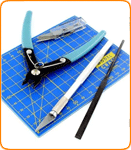RS Models 92293 1/72 Curtiss Hawk II 'Latin America' Floatplane
3 Decal variants:
1. Curtiss Hawk II, Colombian Air Force, Cartagena 1933
2. Curtiss Hawk II, Bolivian Air Force, Grand Chaco War 1933
3. Curtiss Hawk II, Iquitos on the Amazon River, peru 1933
Essentially a modified XF11C-2, the Hawk II was fitted with a Wright R-1820F-3 Cyclone rated at 710 hp. Only the Hawk II was exported in quantity with Turkey, the first customer taking delivery of 1932. Colombia placed an order at the end of October 1932, receiving an initial batch of four twin float-equipped Hawk IIs, the first of a total of 26 float fighters delivered by the end of July 1934. The Colombian Air Force used Hawk II and F11C-2 based in floats in the Colombia-Peru War in 1932-1933. Nine Hawk IIs were supplied to Bolivia, of which three had interchangeable wheel/float undercarriages; four were delivered to Chile, four to Cuba, two to Germany, one to Norway and 12 to Thailand.The Chinese Nationalist Air Force received 52 F11Cs as Hawk IIs and fought against the Japanese during the Second Sino-Japanese War.
The basis of the new fighter was a variant of the proven Hawk P-6E, currently being delivered to the US Air Force. It took over most of the hull structure, a very similar self-supporting landing gear, but with longer legs and side-opening wheel hoods, as well as wings with a wooden frame. But the engine was a novelty, a Wright SR-1820F Cyclone radial nine cylinder, covered by a narrow Townend type ring and a front cover equipped with slots. This Hawk II, as it was named, paradoxically almost immediately aroused the interest of the US Navy, which bought the company's demonstrator a month after its first takeoff in May 1932, assigned it the designation XF11C-2, and almost at the same time ordered a second prototype (XF11C-1) with by the Wright R-1510 two-star engine. The first export Hawk II thus became a fighter-bomber prototype for the US Navy. Export Hawky IIs differed from their brothers built for the Navy, for example, by the absence of a swinging fork, which carried the bomb out of the propeller range during dive bombing, but they could still use a 50-gallon auxiliary tank attached to the fuselage. Of course, they also did not have the grappling hook for landing on the deck of an aircraft carrier, and mostly retained the original spur as well, while the production F11Cs had a completely differently positioned sprung wheel. Armament usually varied according to the wishes and possibilities of the customer, so American 7.62 mm, British 7.7 mm or German 7.92 mm machine guns were used. Under the wings there were hangers for four fifty-kilogram bombs, which were mainly used extensively in Latin America.
1. Curtiss Hawk II, Colombian Air Force, Cartagena 1933
2. Curtiss Hawk II, Bolivian Air Force, Grand Chaco War 1933
3. Curtiss Hawk II, Iquitos on the Amazon River, peru 1933
Essentially a modified XF11C-2, the Hawk II was fitted with a Wright R-1820F-3 Cyclone rated at 710 hp. Only the Hawk II was exported in quantity with Turkey, the first customer taking delivery of 1932. Colombia placed an order at the end of October 1932, receiving an initial batch of four twin float-equipped Hawk IIs, the first of a total of 26 float fighters delivered by the end of July 1934. The Colombian Air Force used Hawk II and F11C-2 based in floats in the Colombia-Peru War in 1932-1933. Nine Hawk IIs were supplied to Bolivia, of which three had interchangeable wheel/float undercarriages; four were delivered to Chile, four to Cuba, two to Germany, one to Norway and 12 to Thailand.The Chinese Nationalist Air Force received 52 F11Cs as Hawk IIs and fought against the Japanese during the Second Sino-Japanese War.
The basis of the new fighter was a variant of the proven Hawk P-6E, currently being delivered to the US Air Force. It took over most of the hull structure, a very similar self-supporting landing gear, but with longer legs and side-opening wheel hoods, as well as wings with a wooden frame. But the engine was a novelty, a Wright SR-1820F Cyclone radial nine cylinder, covered by a narrow Townend type ring and a front cover equipped with slots. This Hawk II, as it was named, paradoxically almost immediately aroused the interest of the US Navy, which bought the company's demonstrator a month after its first takeoff in May 1932, assigned it the designation XF11C-2, and almost at the same time ordered a second prototype (XF11C-1) with by the Wright R-1510 two-star engine. The first export Hawk II thus became a fighter-bomber prototype for the US Navy. Export Hawky IIs differed from their brothers built for the Navy, for example, by the absence of a swinging fork, which carried the bomb out of the propeller range during dive bombing, but they could still use a 50-gallon auxiliary tank attached to the fuselage. Of course, they also did not have the grappling hook for landing on the deck of an aircraft carrier, and mostly retained the original spur as well, while the production F11Cs had a completely differently positioned sprung wheel. Armament usually varied according to the wishes and possibilities of the customer, so American 7.62 mm, British 7.7 mm or German 7.92 mm machine guns were used. Under the wings there were hangers for four fifty-kilogram bombs, which were mainly used extensively in Latin America.
| General Info | |
| Scale | 1/72 |
| Type | Scale Model Kit |
| Subtype | Military Aircraft |
- Stock: In Stock
- Reward Points: 35
- SKU: RS-92293
- 2pcs in Stock

RS Models
MRP: US$27.92 Save: US$4.90
17% OFF
US$23.02
(excl. Tax)
"In-Stock" Really Means It
Combine Shipping & Save
SAME or Next day shipping*
There are no reviews
Maybe you can help? Many users will be grateful to you. And so are we.





















